
|

|

Lotus 72
The 72 was yet another innovative design by Chapman featuring inboard brakes, side mounted radiators in sidepods, as opposed
to the nose mounted radiators which had been commonplace since the 1950s and an overhead air intake. The overall shape of
the car was innovative too, resembling a wedge on wheels which was inspired by the earlier Lotus 56 gas turbine car,
and the layout taken from the Lotus 63 four wheel drive project testbed. The shape made for better air penetration and
higher speeds. In a back-to-back test with the Lotus 49, the 72 was 12mph faster with the same engine.
Chapman's efforts produced one of the most remarkable and successful designs in F1 history. Taking the stressed engine
layout technique from the Lotus 49 and adding advanced aerodynamics produced a car that was years ahead of its rivals. To
begin with however, problems with the handling of the car had to be overcome, due to a lack of 'feel' caused by the anti-dive
suspension geometry - which was designed to prevent the nose of the car dipping significantly under braking - and the anti-squat
set-up at the rear, which was supposed to stop the car 'squatting down' under acceleration. Once the suspension was modified,
there were no further problems. The car caused a sensation amongst the media and fans, with many people clamouring to see
the remarkable car in action.
The car was introduced partway into the 1970 season, driven by Jochen Rindt and
John Miles. Rindt made the car successful, winning four Grands Prix in quick
succession. Rindt was almost certainly going to win the world championship but was killed in a qualifying crash at Monza, driving the 72 with its critically important wings removed. His replacement, Emerson Fittipaldi won the American race, helping Rindt become F1's only posthumous World Champion. Rindt and
Fittipaldi's combined points for the season helped Lotus to its fourth constructors' championship.
The car was developed during 1971 by BRM incumbent Tony Rudd. He worked especially on redesigning the rear suspension
and modified the rear wing to produce more downforce. Fittipaldi struggled during the season but scored good results and finished
a respectable sixth, whilst the following season was much better. The development work done behind the scenes helped him become
the youngest world champion in F1's history in 1972 winning five races in the 72, whilst Lotus again won the constructors'
championship. The car now sported a striking paintscheme of black and gold; Imperial Tobacco had introduced a new
brand, and decided to increase exposure and provide more funds to Lotus as part of the deal. Lotus was now sponsored by John
Player Special cigarettes.
The 1973 season saw new rules introduced to increase car safety. This included mandatory deformable structure to be built
into the sides of the cars, causing the 72 to be further updated with integrated sidepods, larger bodywork and new wing mounts.
Fittipaldi was joined for 1973 by the brilliant Swede Ronnie Peterson . Peterson fell in love with the 72; a perfect
marriage of car and driver. In his first season with Lotus, Peterson won four races, while Fittipaldi won three, but their
internal fight helped Jackie Stewart snatch the drivers' championship, while the large points tally built up by their two
drivers helped Lotus keep the constructors championship. Fittipaldi left for McLaren for 1974.
This left Peterson as team leader, while Jacky Ickx joined the team to partner him. The 72 was meant to be replaced
by the Lotus 76, intended to be a lighter and leaner version of the 72, but the cars' technology proved to be too ambitious
and the project flopped. Lotus turned to the venerable 72 for the 1974 season. A further update to the car, increasing the
front and rear track kept the car competitive. Peterson won another three races and challenged for the championship in a very
closely contested season, ably supported by Ickx who turned in solid performances and scored several podiums. The now aging
72 did remarkably well for a four year old design, finishing fourth in the constructors championship but for 1975 without
a replacement chassis the 72 was again pressed into service. By now it was obvious that the car, even with further modifications
was no match for the new Ferrari which took the title and Lotus finished 6th in the constructors' championship.
After 20 wins, 2 drivers' and 3 constructors' championships, the 72 was retired for the 1976 season and replaced by the Lotus
77.
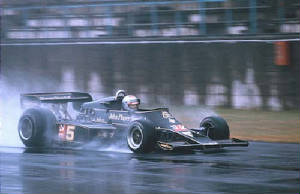
Lotus 77
The Lotus 77 was designed by Colin Chapman and Ralph Bellamy to replace the obsolete Lotus 72 in 1976. It was based on
the 72 and partially on the McLaren M23. The car had unusual front suspension designed to be changed for each race to best
suit the track. This proved to be problematic, so later in the season a standard arrangement was adopted.
After Mario Andretti's first drive in the car, he declared the car to be a dog, but he and Gunnar Nilsson were able to
drive the car into podium finishes in the second half of the season once the car had been developed. The car was best suited
to tracks with very long corners such as Anderstorp and Zandvoort, where at both tracks Andretti was able to challenge for
victory.
Mario did win the final race of 1976 held in torrential rain at Mount Fuji by a whole lap, but he was glad to trade in
the car for the Lotus 78 for 1977.
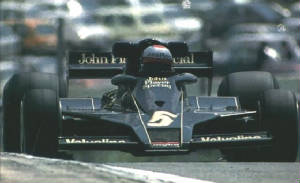
Lotus 78
The Lotus 78 'wing car' was a Formula one racing car used in the 1977 and 1978 seasons. It was designed by Peter Wright, Colin
Chapman, Martin Ogilvie and Tony Rudd, and was the car that started the ground effect revolution in Formula 1.
In early 1976, spurred on by the disappointing lack of pace of the ageing Lotus 72 the previous season, and the indifferent
performance of the current Lotus 77, Chapman wrote a 27 page document detailing his ideas on low drag air penetration. After
careful examination of Bernoulli's principle of fluid dynamics, he had thoughts on the effects of an upturned aeroplane wing
profile fitted to the car, and gave the document to his head of engineering Tony Rudd.
Rudd appointed a team to work on the project: chief designer Ralph Bellamy, vehicle engineer Martin Ogilvie and aerodynamicist
Peter Wright. Rudd and Wright had previously worked for BRM, and before joining Lotus in 1970 had done a design study into
the possibility of an inverted wing profile fitted to one of their cars. Rudd had tested a number of scale models, but lack
of the right testing methods and BRM's declining fortunes meant development had never got beyond the experimental stage. However,
Wright remembered their work and brought it into the project.
Wright then set about experimenting with F1 car body shapes using a wind tunnel and a rolling road, when by happy accident
he began to get remarkable results in one of the models. Closer inspection found that as the rolling road's speed increased,
the shaped underbody was being drawn closer to the surface of the road. Wright experimented with pieces of cardboard attached
to the side of the model car body, and the level of perceived downforce produced was phenomenal. The results were presented
to Colin Chapman, who gave the team free reign to come up with an F1 chassis design. After a round of design sketches and
engineering drawings, and further work in the wind tunnel at Imperial College the car was put into production. Five examples
were built, codenamed John Player Special Mk. III, otherwise known as the Lotus 78 which appeared in July of 1976. Mario Andretti
wanted to introduce the car early, possibly at the Dutch Grand Prix that year but was overruled by Chapman, as he didn't want
other teams discovering what Lotus had achieved. The 78 was introduced at the first race of 1977, and proved to be the class
car of the field that season, winning five races. The car proved relatively easy to set up and modify, with particular attention
paid to the undercar aerodynamics and their interaction with the track surface, hence a stiffer suspension design which was
required to maintain the aerodynamic effects.
The 78 was loosely based on the Lotus 72, sharing the same basic wedge shape and internal layout, but featuring detailed aerodynamic
improvements, better weight distribution and a longer wheelbase. It had a slimmer, stonger monocoque cast in aluminium with
fibreglass body panels. The car created quite a stir when it first appeared, and outwardly seemed ahead of its time. Internally
of course, it was a quantum leap ahead. Andretti worked hard with the car, testing for many thousands of miles at the Lotus
test track in Hethel.
Based on Bernoulli's discoveries, the underside of the sidepods were shaped as inverted aerofoils, in the same vein as conventional
wings but on a much larger scale. Wright and Chapman had discovered that by shaping the floor of the car in this way, they
could accelerate the air passing through the gap between the ground and the underside, thereby reducing the air pressure under
the car relative to that over it. This created a partial vacuum, effectively sucking the vehicle down which forced the tyres
harder onto the track. The greater force downwards on the tyres gave more grip and thus higher cornering speeds. To make the
suction effect as great as possible, the monocoque was slimmer, forcing the air passing through between the ground and the
inverted wing shape cover as much area under the car as possible. Ground effect had the great advantage of being a low drag
solution unlike conventional wings, meaning that the increased cornering ability was not compromised by a decrease in straight-line
speed. If anything, because of the decreased air resistance, the top speed of the car also increased accordingly.
To begin with, brushes were fitted to the base of each sidepod to keep the low pressure area under the car. When these proved
insufficient, Lotus tried plastic skirts, but these abraded very quickly, until finally moveable rubber skirts were developed
which proved very effective. The sliding skirts sealed the gap between the sides of the cars and the ground and prevented
excessive air being sucked into the low pressure area under the car and dissipating the ground effect. Andretti described
driving the 78 as if it was 'painted to the road.'
The fuel tanks were three separate cells, with one behind the driver and one each in the mid-section of each sidepod. The
sidepod tanks could be controlled from the cockpit by the driver and could be used to fuel the engine separately or together,
improving performance and weight bias in cornering. The suspension set up from the previous Lotus 77 was used, with the suspension
designed for quick changes in geometry. This helped set the car up for a specific circuit when required.
Unfortunately, the low pressure area under the car was too far forward, requiring a very large rear wing to be designed resulting
in a lot of drag at high speeds. This was especially noticeable on fast tracks such as Hockenheim and the Österreichring,
where the Ferraris and McLarens were much faster than the 78. To compensate, Ford provided development versions of the Ford
Cosworth DFV, increasing the car's speed but also sacrificing reliability. Andretti had no less than five engine failures
in 1977, costing him the world championship to Niki Lauda, even though he had won four races and taken six pole positions
to Lauda's three wins. Eventually a smaller wing was designed in time for the Italian Grand Prix (see above picture), which
cut the drag factor significantly, and allowed Andretti to take a popular 'home' victory. Another problem was with the rear
suspension, which although slightly modified to allow clearer airflow from the rear of the sidepods, it was still directly
in the path of the exiting air, which affected the stability of the back of the car, causing oversteer.
It was obvious that the 78 was something special though, as proved by Andretti and Gunnar Nilsson who won once in Belgium.
When the car worked well it was almost uncatchable. Other teams started scrambling to design their own version for 1978. The
problem they had was that they didn't know exactly what was so special about the car, as Chapman and other members of Lotus
came up with any number of excuses to hide the real reason. That as well as the skirts, which hid any view of the underside
of the car.
The 78 was good enough to still be a winner in early 1978, with Andretti and Ronnie Peterson scoring a win each and another
3 pole positions before it was replaced by the Lotus 79, which was as far ahead of the 78 as the 78 had admittedly been ahead
of the rest of the field in 1977. The 78 was to see one further works team start, however. Owing to damage sustained to his
79 in practice, Ronnie Peterson was forced to use the reserve car to qualify for the 1978 Italian Grand Prix. The car had
not been maintained or developed by the team as they concentrated on the 79, and the car was hurriedly prepared for the race.
Although his team mate predictably romped away with pole position, the slower 78 was only good enough for fifth place on the
grid for Peterson. Sadly, this meant that he was caught up in a massive start line accident, which resulted in his car ramming
the barriers nose-first, completely destroying the front end of the vehicle. Peterson later died owing to complications arising
from the treatment he received following the crash.
The original development prototype was sold to Hector Rebaque. He ran this car through his Rebaque privateer team in World
Championship events during 1978 and 1979, and in non-Championship races into the early 1980s.
In all, the Lotus 78 took seven wins, nine pole positions and scored 106 points in its career.
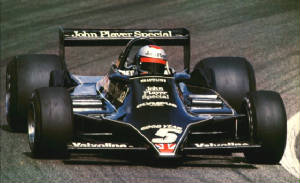
Lotus 79
The Lotus 79 was an F1 car designed in late 1977. It is considered by many the most significant and respected
racing car design of all time.
The Lotus 79 was the first F1 car to take full advantage of ground effect aerodynamics, pioneered in its immediate
predecessor, the Lotus 78. The undercar pressure problems in the 78 were resolved with the 79, with further design work
on the venturi tunnels under the car, which allowed the low pressure area to be evenly spaced along the whole of the underside.
This was achieved by extending the rear bodywork to a point inside the rear wheels, allowing the underside to extend further
back, instead of ending abruptly in front of the rear wheels on the 78. As a result, the rear suspension was also redesigned
to allow the air to exit the rear more cleanly than on its predecessor. This allowed a smaller rear wing to be designed, causing
less drag. When the car first appeared, the upper bodywork was steeply raked and featured coke bottle sidepods. After work
in the wind tunnel, these features were found to be unnecessary, as the car generated so much downforce anyway. These features
were however later incorporated into the Lotus 80.
The car was powered by the Cosworth DFV and constructed of sheet aluminium honeycomb, specially strengthened
for the pressures exerted on the car by the ground effects. The fuel tank was one single cell behind the driver, as opposed
to separate fuel tanks as on the 78. This had the advantage of increasing fire protection and moving the centre of gravity
to the middle of the car, helping cornering and braking. The 79 was also the first F1 car to be designed using wind tunnel
and computer design aids. In fact it was the first F1 car to use computers to analyse it in the pits on race weekends.
The car was secretly tested in late 1977 by Ronnie Peterson and proved extremely fast, but the chassis suffered early
fatigue due to the severe suction and g-force generated by the ground effect. The 79 produced about 30% more downforce than
the 78, something not foreseen by Ogilvie and Rudd, who went back to the drawing board. The chassis was strengthened in specific
points, mostly around the monocoque and load bearing points on the chassis tub, and the car was found to be even faster than
before.
The need for smooth airflow dictated the car must have clean lines; as a result the 79 was one of the most beautiful cars
ever to take to the track. Nicknamed 'Black Beauty' by the press and F1 fans alike, for its graceful design and sleek profile
and its black and gold livery through sponsorship by John Player Special cigarettes, the Lotus 79 was instantly competitive
on its debut at the Belgian Grand Prix. It took pole at the hands of Andretti by more than a second, and won the race
comfortably. Andretti said after driving the 79 for the first time that the Lotus 78 was like driving a London bus. He did
however have reservations over the car's brakes, which faded noticeably over a race distance. Peterson once quipped, after
scoring an impressive pole position, that the car was so brilliantly set-up all he had to do was steer.
The 79 proved to be almost unbeatable during 1978 and provided an unprecedented level of domination. The car took
six more victories during the season, giving the drivers' championship to Andretti, and the constructors' championship to
Lotus. Its only serious rivals during the season were Ferrari and Brabham with their 'fancar'. The fan car
only raced once, winning the Swedish Grand Prix, before the FIA banned the concept. Meanwhile, the Ferraris only won
when the Lotus failed to finish. So superior was the Lotus, that most races became a scrap for minor placings, as Andretti
and Peterson regularly finished first and second, more often than not by a considerable margin ahead of the rest of the field.
On the rare occasion the 79 did not win or fail, one or other driver was usually on the podium. Andretti was comfortably world
champion in 1978, and Peterson finished the season as the runner-up although posthumously as he was tragically killed in a
startline crash at Monza, ironically, the race where Andretti wrapped up the championship. Incidently, Peterson was not in
the 79 for that race, but in fact last year's 78 due to a heavy crash in practice and him being unable to fit into Andretti's
spare car.
In 1979, the 79 was to be replaced by the Lotus 80, intended to be the next step in the evolution of ground effects. Martini
replaced JPS as sponsor in that year, so the car appeared resplendent in British Racing Green. The 80 proved to be a
total failure and Lotus was forced to go back to the 79, driven by Andretti and Reutemann. Several podium places were
scored and the 79 was in contention for victory in the early stage of the season, but unfortunately the next generation in
ground effects cars led first by the Ligier, then Ferrari and then Williams, outclassed the 79. Although the car was
updated, Lotus slipped to fourth in the constructors' championship and the car was retired at the end of the 1979 season,
without winning any further races.
In its lifetime, the 79 took 7 wins, 10 pole positions, 121 points and won the last drivers' and constructors' world championships
for Lotus.
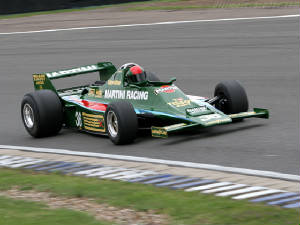
Lotus 80
The Lotus 80 was an attempt by Team Lotus to take ground effect as far as possible. It was designed by Colin Chapman,
Martin Ogilvie, Peter Wright and Tony Rudd for the 1979 season.
Ogilvie and Rudd reasoned that to take a further step ahead of the competition, the new car should be designed as one
huge ground effect system, starting just behind the nose and extending all the way to the back of the car beyond the rear
wheels. An additional ground effect system was built into the nose, in an effort to turn the whole chassis into an aerodynamic
device. In theory this would create a tremendous amount of downforce, so the chassis would have to be built to be more structurally
rigid than the Lotus 79's. The 80 also would not need wings due to the massive downforce. Chapman approved the idea at once.
The car appeared resplendant in British racing green, since John Player Special had pulled out of F1. The car featured
'coke bottle' sidepods, something that would become familiar in the 1980's. However a serious problem was encountered during
testing. Mario Andretti reported that at speed the car behaved very well, but in braking and cornering, where speeds were
lower, the car lost downforce alarmingly. The problem was twofold, firstly, the ground effect's low pressure area under the
car was moving around with the car's centre of gravity. The phenomenon was known as 'porpoising,' as the car appeared to be
lifting and squatting at different speeds, causing it to lurch violently through corners. Secondly, the slightest difference
in track ride height including off cambered corners, kerbs etc affected the undercar pressure hugely. The team experimented
by fitting the car with wings, but this had little effect on the way the car behaved. Andretti persevered with the car, but
his new team mate Carlos Reutemann refused to drive it and stayed with the Lotus 79.
Chapman eventually had to admit the 80 was not the wondercar he had planned, and after a reasonable third place for Andretti
in the Spanish Grand Prix, the problems with the Lotus 80 became obvious in Belgium and Monaco. The Lotus 79 was modified
and pressed back into service.
It was a massive setback for the team, and for the car which had appeared so promising, however Chapman persevered with
the concept of a full length ground effect chassis in the Lotus 88.
|

|

|

|

|

|
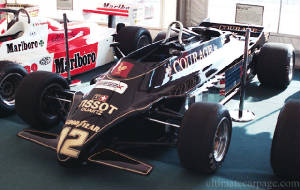
Lotus 88
The Lotus 88 was an innovative ground effect car designed as a response to technical regulations introduced
in 1981 by FISA to curb the ground effects cars technical excellence.
By 1981 the ground effects cars were so efficient and so fast that the drivers were suffering from the tremendous g-forces involved
in cornering and braking. The FIA banned the moveable skirts fitted to the bottom of the cars' sidepods that were vital for
achieving consistent ground effect and regulated a mandatory ground clearance of 6cm, in the interests of driver safety. The
Brabham team were the first to circumvent the rules using hydraulic systems which compressed under aerodynamic loading
and lowered the Brabham car onto the track. This had the side effect of rendering the car without any sort of suspension,
causing the driver to be buffeted even more than before. However, the performance gains were such that other teams were soon
following suit - although most had difficulty in replicating the Brabham system and used a simple switch to lower the car.
Chapman had other ideas.
The earlier Lotus 86 had been designed at the time when skirts were still legal, in the same layout as the 88 but only
one prototype had been built. The performance gains were relatively small but significant over conventional ground effects
cars. When the skirts were banned, Wright studied the car and its performance without skirts. The loss in performance was
largely negligible, so the 88 was quickly designed as a re-engineered 86. The 88 used an ingenious system of having a twin
chassis, one inside the other. The inner chassis would hold the cockpit and would be independently sprung from the outer one,
which was designed to take the pressures of the ground effects. The outer chassis did not have discernable wings, and was
in effect one huge ground effect system, beginning just behind the nose of the car and extending all the way inside the rear
wheels, thereby producing massive amounts of downforce. The car was powered by the Ford Cosworth engine. Lotus drivers Mansell
and De Angelis reported the car was pleasing to drive and responsive. To make the aerodynamic loads as manageable
as possible, the car was constructed extensively in carbon fibre, making it along with the McLaren the first car to use the
material in large quantity.
Other teams were outraged at this exploitation of the regulations and protests were lodged with the FIA, on the grounds
that the twin chassis tub breached the rules in terms of moveable aerodynamic devices. The FIA upheld the protests and consequently
banned the car from competing. Chapman was adamant the car was legal and challenged the other teams and the FIA at every turn,
but the decision stood. Chapman was forced to update two of his Lotus 87 chassis as replacements for his thwarted brainchild.
The Lotus 88 therefore remains a curiosity from a bygone age of F1. Some of the 88's aerodynamics and layout were worked into
the successful Lotus 91 which followed in 1982
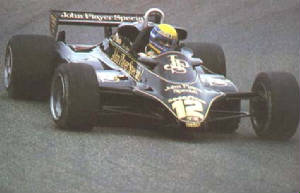
Lotus 91
The Lotus 91 was designed by Colin Chapman, Martin Ogilvie and Tony Rudd for the
1982 season. After several uncompetitve seasons with experimental or mediocre cars, Colin Chapman went back to basics and
designed the graceful Lotus 91, powered by the Ford Cosworth DFV. Following Brabham's lead, the new car was the first Lotus
chassis to use carbon brakes, improving braking performance considerably.
After a design study by Chapman into new
composite materials, the decision was taken to to build the car in carbon fibre, making it along with the McLaren MP4/1 the
first F1 car to be built from the material.
The suspension was revolutionary. Using an on-board system to control
the ride height and behavior of the suspension, the Lotus 91 was the first car to be fitted with active suspension. The system
was partially controlled by computers, but at this early stage was mostly operated by hydro-pneumatic valves.. Elio De Angelis
used the car well, but found the 91 was mostly competitive on ultra fast tracks like Hockenheim, Monza and the Osterreichring.
The latter track provided a thrilling final lap win for De Angelis against Keke Rosberg in the Williams. That as well as several
other podium places helped the team to fifth in the final standings in 1982, before ground effects were banned for the 1983
season, and the 91 was replaced by the first Lotus turbo car. The 91 was the last F1 car to win a race under Colin Chapman's
rule before he died of a heart attack in December 1982.
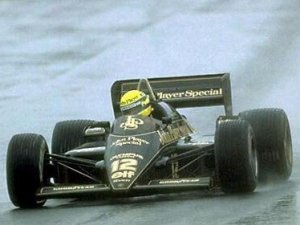
Lotus 97T
The Lotus 97T was a development of the Lotus 95T of 1984. It was designed for the 1985 Formula 1 season by Gerard Doucarouge
and powered by a 1500cc Renault turbocharged engine. Sponsorship came from John Player Special and French oil company Elf.
The 97T was a simple design but was robust and powerful. It did feature another innovative piece of Lotus design: an early
form of bargeboards.
Lotus' major coup for 1985 was signing rising star Ayrton Senna from the Toleman team to partner Elio De Angelis. De Angelis
had finished third in the previous season's drivers' championship and had had many promising results with the 95T. The 97T
was a natural development, but taking into account new sporting regulation changes over the rear wings of the cars.
The 97T was very competitive during the season, taking 8 poles, 7 with Senna and 1 with De Angelis and 3 wins. Senna's
first was a brilliant performance in Portugal where he won by over a minute in monsoon conditions. His second came at Spa,
held in wet/dry conditions. De Angelis added a third win at Imola after Prost was disqualified.
The 97T was fast but was unreliable. Senna in particular has a run of bad luck mid season, many times while leading which
cost him a possible chance at the world championship. Eventually, Lotus finished third in the constructors championship. The
97T was updated for 1986 and at the hands of Senna won another two races in Spain and Detroit, and another 8 pole positions.
Lotus again finished third in the constructors' championship, but Senna was able to mount a consistent challenge for the drivers'
title, mostly down to improved reliability.
The car was a brief return to the glory days of the '60s and '70s for Lotus, scoring 5 wins, 16 pole positions and 129
points. It was replaced by the Lotus Honda 99T for 1987.
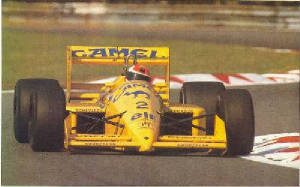
Lotus 99T
The Lotus 99T was designed by Gerard Ducourouge for the 1987 season. After Renault pulled out of F1 at the end of 1986,
Lotus signed a deal with Honda to use their massively powerful and technically advanced turbo engine. In exchange, Lotus agreed
to sign a Japanese driver as team mate to Ayrton Senna, so picked up Saturo Nakajima.
The 99T was a very nimble car and was a big step forward over the unreliable and fuel guzzling 97T. It was also the first
Lotus chassis to use fully active suspension for a whole season. Ducourouge worked hard on the aerodynamics, hoping to bridge
the gap between Lotus and Williams. The fact that both teams used the same engine seemed to be a sign of good things to come.
However, the Williams FW11 was still the car to beat and Nigel Mansell and Nelson Piquet's mutual dislike pushed Williams
far ahead of the competition. Senna did score two excellent wins in Monaco and the USA (the last for Team Lotus), almost added
a third in Italy and scored several podium places, but he was unable to mount a serious challenge for the title, leaving him
to join McLaren for 1988.
His place was taken by Piquet who was able to perform promisingly in the early part of the season, but the sheer domination
of McLaren curtailed Lotus' progress.
The 99T scored 2 wins, 1 pole position and 87 points in it's career.
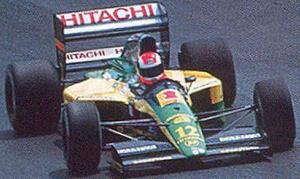
Lotus 107
The Lotus 107 brought in a final, frustratingly limited and short-lived period of competitiveness for the legendary Team
Lotus in Formula 1. A fresh design by Chris Murphy, it had smooth sweeping lines a world away from the long developed and
antique looking 102D. Lotus also harked back to previous glories with a supply of Ford Cosworth HB V8 engines, of a similar
- if older - specification to those being used by Benetton. The 107 was the first Lotus to be fitted with a semi automatic
gearbox.
With a top notch driving squad of Johnny Herbert and a future double F1 World Champion Mika Häkkinen, the Lotus' were
able to bring in some good results - at several races the Lotuses were able to run in formation on the tail of the leading
pack, at least in the early parts of the races. Reliability was not fantastic, but a fair measure of basic speed was obviously
there. For a while in 1992 and '93 it seemed as if Team Lotus might be able to turn things around and claw their way back
to success. The team was able to score consistent points finishes and several podium places during both seasons.
The car was developed over succeeding seasons into B and C variants, the latter with Mugen-Honda power in place of the
Cosworth. As was obligatory at the time, the team employed the active suspension technology that they had introduced to F1
back in 1987 on later variants, but the budget wasn't there to make it really work, and besides, it was now far from being
a unique capability. Alex Zanardi believes that the focus on this system was to the detriment of other aspects of the car.
Zanardi (later a two-time Champ Car champion) was an example of the high level of driving talent the team generally continued
to employ. Sadly the team's financial difficulties dragged it under at the end of 1994. The Lotus 109, the last Formula 1
Lotus, which ran in the latter part of 1994, was a further derivative of this design.
|

|

|

